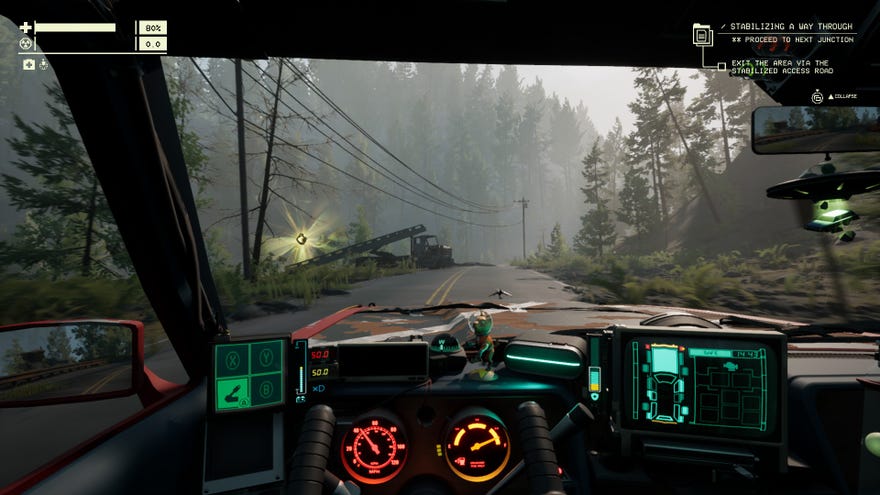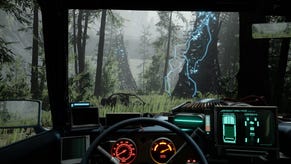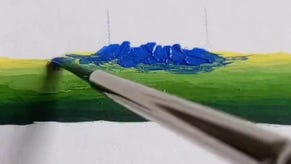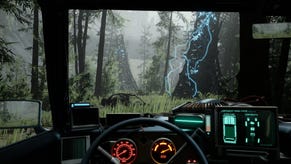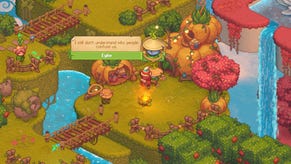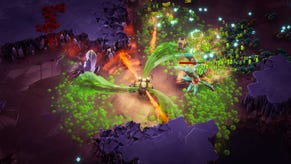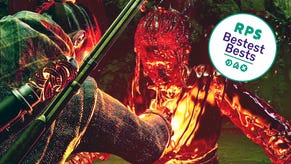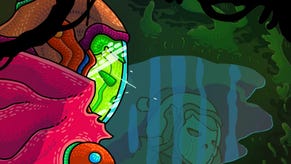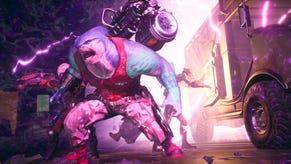Pacific Drive review: the car's the star in this atmospheric yet unwieldy survival game
Hard driving
Playing Pacific Drive reminds me of an army recruitment advert shown on British TV about 20 years ago. A group of soldiers are travelling along a road at night in a Land Rover, when suddenly they spot the enemy ahead. The front seat passenger starts barking orders at the driver: “Get off the road! Kill the lights! Through the trees!”. You sense the panic as the camera, inside the vehicle, jolts with the suspension on the rough ground, and the driver fights the steering wheel to stay in control. It’s a scene you reenact quite frequently in Ironwood’s survival game with roguelike trimmings. Well, except, instead of a Land Rover you’re behind the wheel of a rusty station wagon, and instead of military opposition, you’re scarpering from paranormal phenomena.
As far as I’m concerned, though, those phenomena make a positive change, as they are as fascinating as they are dangerous. While not extra-terrestrial, but ‘anomalies’ resulting from some top secret research in this abandoned region of the US, they could well have been extracted from an Area 51 conspiracy discussion board – green clouds of radioactive dust, glowing pink fungal growths, wobbly UFOs, turbo-charged scrap metal tumbleweeds, and plenty more. Some send the systems in your car haywire, others fry you with electricity, another launches you skyward to land with a bone-jarring thump. Couple this with natural hazards such as fallen boulders and trees, and you’re always ready to swerve off the verge, or barrel blindly into roadside shrubbery.
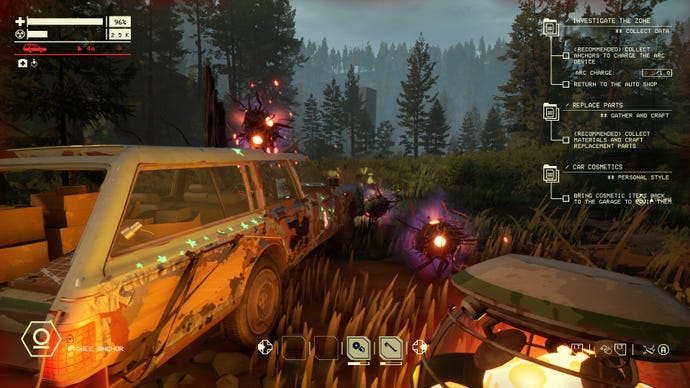
I say blindly because it’s dark more often than it’s light, and because your default headlights – when they aren’t already smashed – are about as luminescent as a candelabra. So when you’re trying to outpace a radiation or acid storm, there’s always a chance you’ll get beached on debris or end up rolling down a muddy slope after gambling on a cross-country sprint. But you do it anyway, as sure as if a sergeant was sitting next to you yelling “Get off the road!” because it’s one heck of a ride. That, in part, is because the car’s fragility is so expertly conveyed – the way it slides and grips, bounces with loose suspension, chassis screaming, dashboard lights panicking, straining under extreme pressure. And never is it tested more than the finale of a mission, when you beeline to a teleporter beam chased by a deadly energy, praying your ailing metal box keeps ploughing forward.
Where the army ad ends on such high notes, though, Pacific Drive's sprint finishes don't. In quiet moments on the road or back at your workshop after a run, you have to undo the damage that results from driving a barely roadworthy vehicle barely on the road. What comes next is the painstaking process of fixing, sealing, refilling and replacing to suture all the injuries incurred.
As you might expect, this is less exciting, but such downtime is not unwelcome, especially mid-journey. Each trip you make into the sealed off exclusion zone is divided into maps you travel across and around. These square areas are dotted with buildings where you can snaffle resources, skeletal vehicles you can grind up for materials or relieve of any remaining fuel, plus a surprising amount of other old stuff that can be chipped and hammered into its constituent parts. But between foraging and close encounters, you make running repairs, as tires burst and doors crumple, threatening to fall off their hinges, and it’s easy to get absorbed in this work. With nothing but occasional radio contact with a few NPCs for company, the driver-car bond is Pacific Drive’s core character relationship: you look after it and it looks after you. Just be careful not to bang your head when you close the boot.
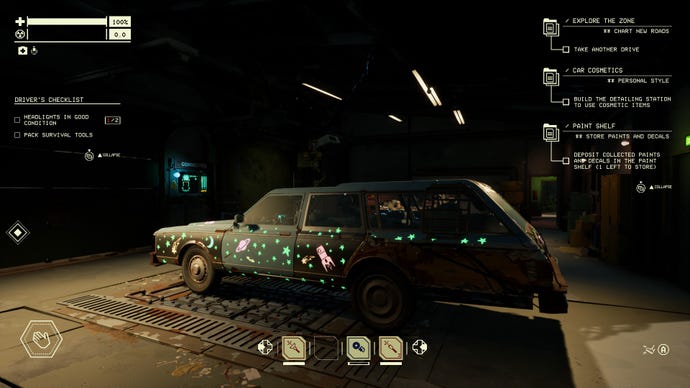
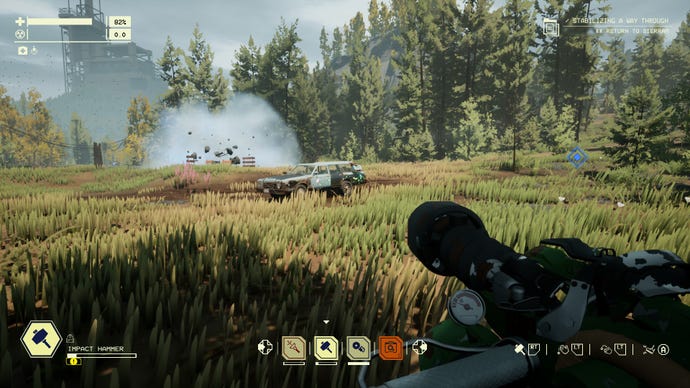
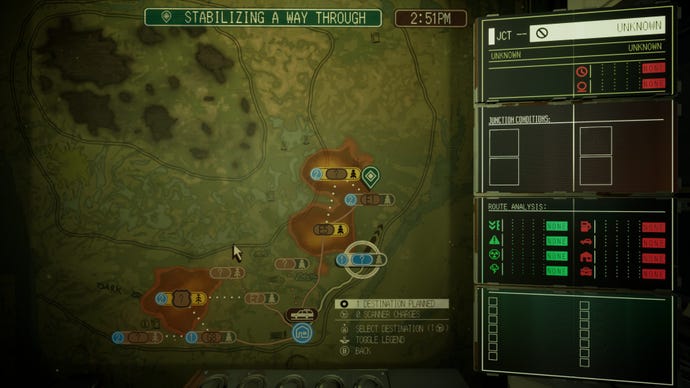
Despite how well the premise of driving and surviving alone is realised in Pacific Drive, however, it’s also often a bit fiddly, long-winded and even a touch mean-spirited. More than anything, perhaps, it could do with extra shortcuts, both on the road and in the garage, to keep its qualities front and centre without bogging itself down. Compared to something like Forever Skies – a similar core concept in a different shape – its loop is over-stretched and lacks self-reinforcing momentum.
Let me tell you about repair putty, for example. After each trip into the wilderness, your car usually returns in a sorry state, for which the primary solution is this common craftable item. But one of the ingredients for repair putty is chemicals, and chemicals aren’t common at all. Around your workshop there’s a self-refreshing supply of other raw materials – metal, rubber, wiring – ensuring you can craft essentials, but no stock of chemicals, so you often have to build new doors for your vehicle rather than mend the ones you've got. Then, when you do get your hands on putty, it’s incredibly slow to use. You stand in front of a panel or door. Hold the button for a couple of seconds. Watch the scrape and slather animation play out. Move to the next plane of bodywork. Repeat. The routine soon wears as thin as the supply of chemicals.
I generally like when games recreate little processes of manual labour, such as the machinic operations in Far: Lone Sails or making coffee in Mundaun. I like some such details here too, like turning the ignition key and flicking the gear stick from park to drive and then back when the car's stopped (the car will roll away if you forget). But when little processes add up to spending 20 minutes preparing for a journey, and the controls for tinkering are overly fussy, I lose my enthusiasm. It’s worse as well if you fail to return from a trip safely, like a dose of extra punishment as you lose almost everything you collected, then have to rebuild virtually from scratch (mercifully, some assist options can help reduce the tedium).
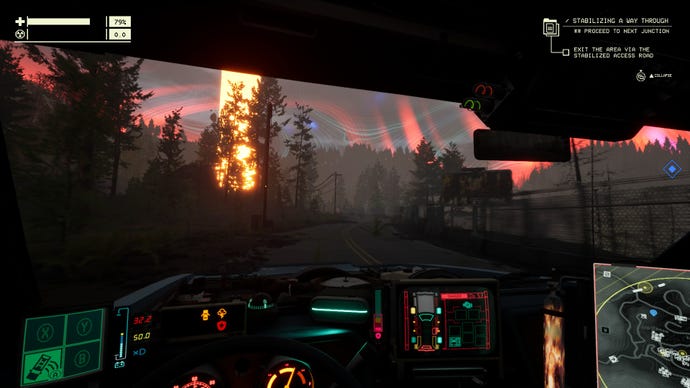
Garage time in Pacific Drive could be the perfect comedown after a bruising journey if it was all about crafting new inventions and experimenting with setups, but in practice it’s more akin to leaving for a holiday – double-checking you’ve packed everything, filled up the petrol and asked the neighbour to feed the cat (OK, not the last one). Upgrades that actually make life easier or more entertaining, like a pulse that violently repels sticky adversaries, require masses of resources to blueprint and build, and even then they might get broken, which often limits your construction efforts after a run to making slightly stronger panelling and more robust tyres instead. You can spend an hour on the road, only to pour much of your haul into putting your car back to how it was before you set out.
That hour or so on the road is a bit much too, especially since there’s no way to even save and quit when you’re out there. Few maps can be crossed quickly, plus if you want to come back well-stocked, you park frequently to forage, and if you want to stay healthy, you take detours around the gnarliest hazards. While the layouts of locations change each time, once you’re deep into the game and have to drive four maps to reach the next key objective, there’s not enough variety to make you appreciate the sights all over again. Even more galling is when you complete a distant objective but don’t reach the teleporter beam in time, and have to repeat the whole trip.
All of which is to say that while Pacific Drive has trunk loads of atmosphere, a powerfully engaging premise, and simulates the feel of driving a quirky old machine in admirable detail, it’s all locked into a laborious framework. For all those “Get off the road!” moments, the processes of gathering, crafting and advancing through its story are fraught with irritating potholes and diversions. With all the repetition of mundane tasks, I imagine it’s closer to the reality of being in the army than that old advert ever was.
This review is based on a review build of the game provided by publishers Kepler Interactive.
